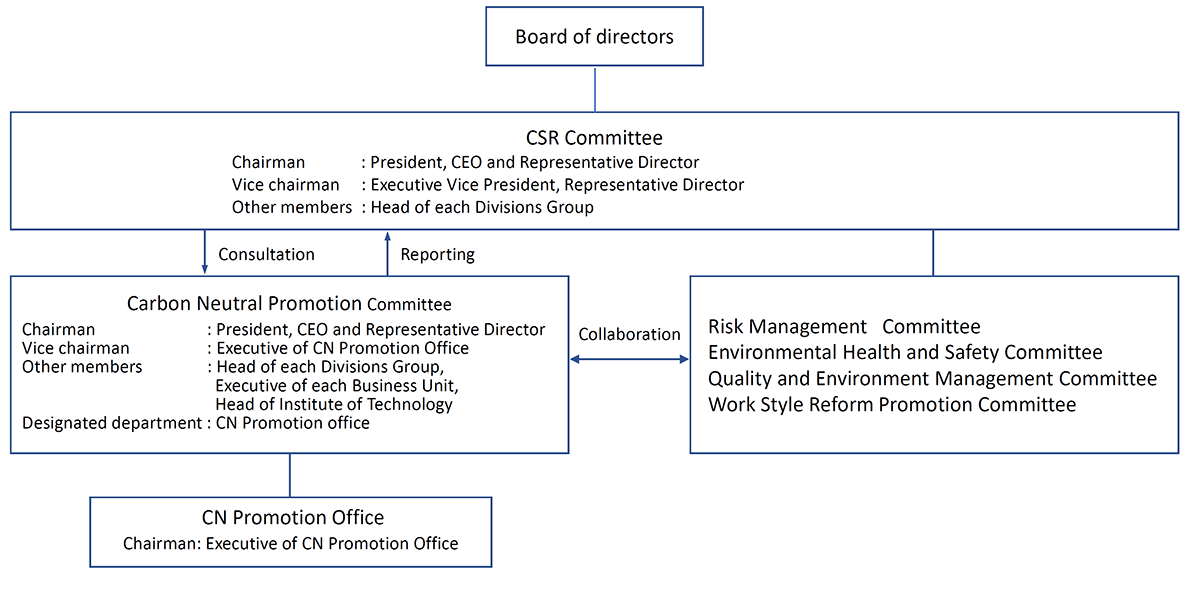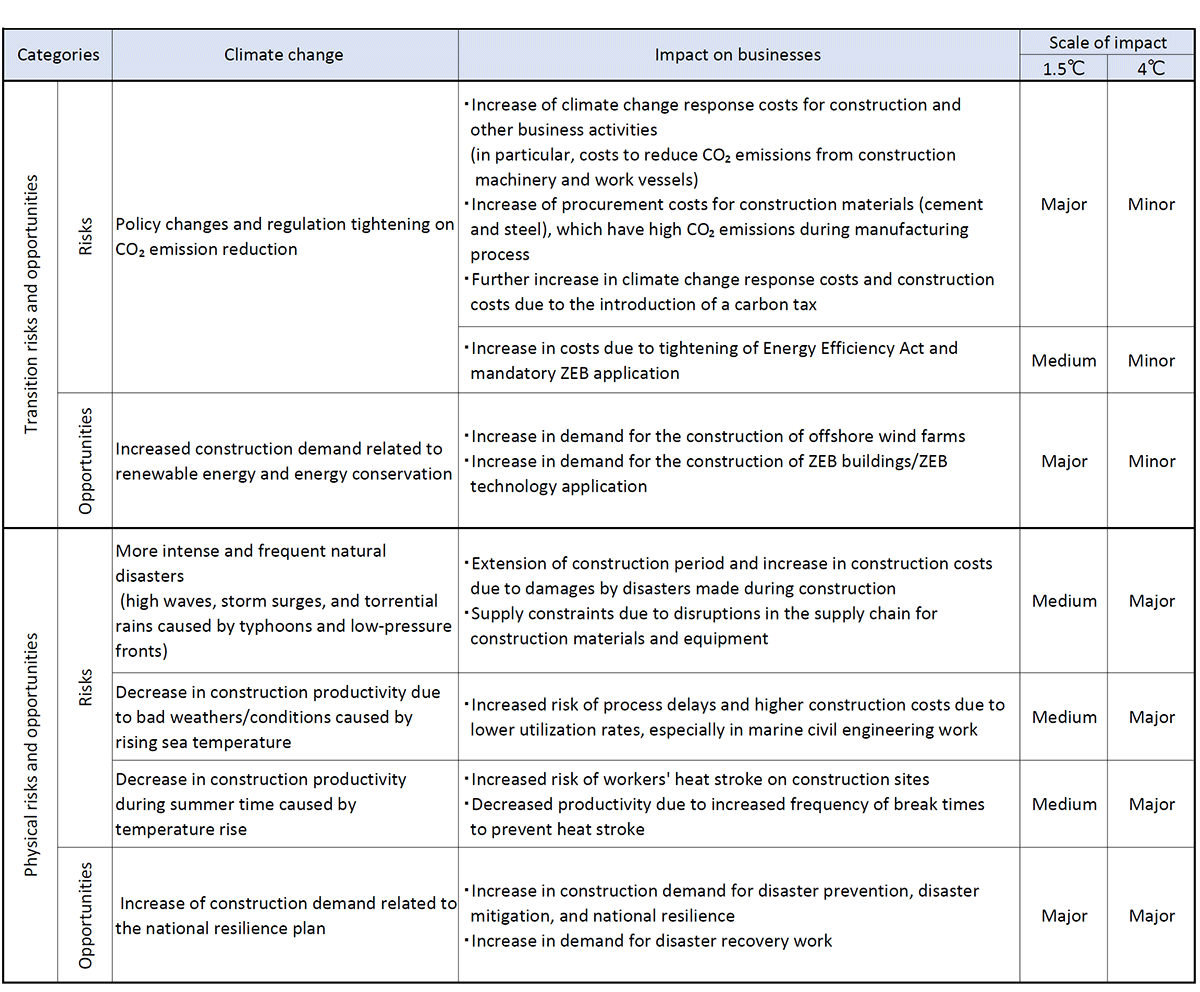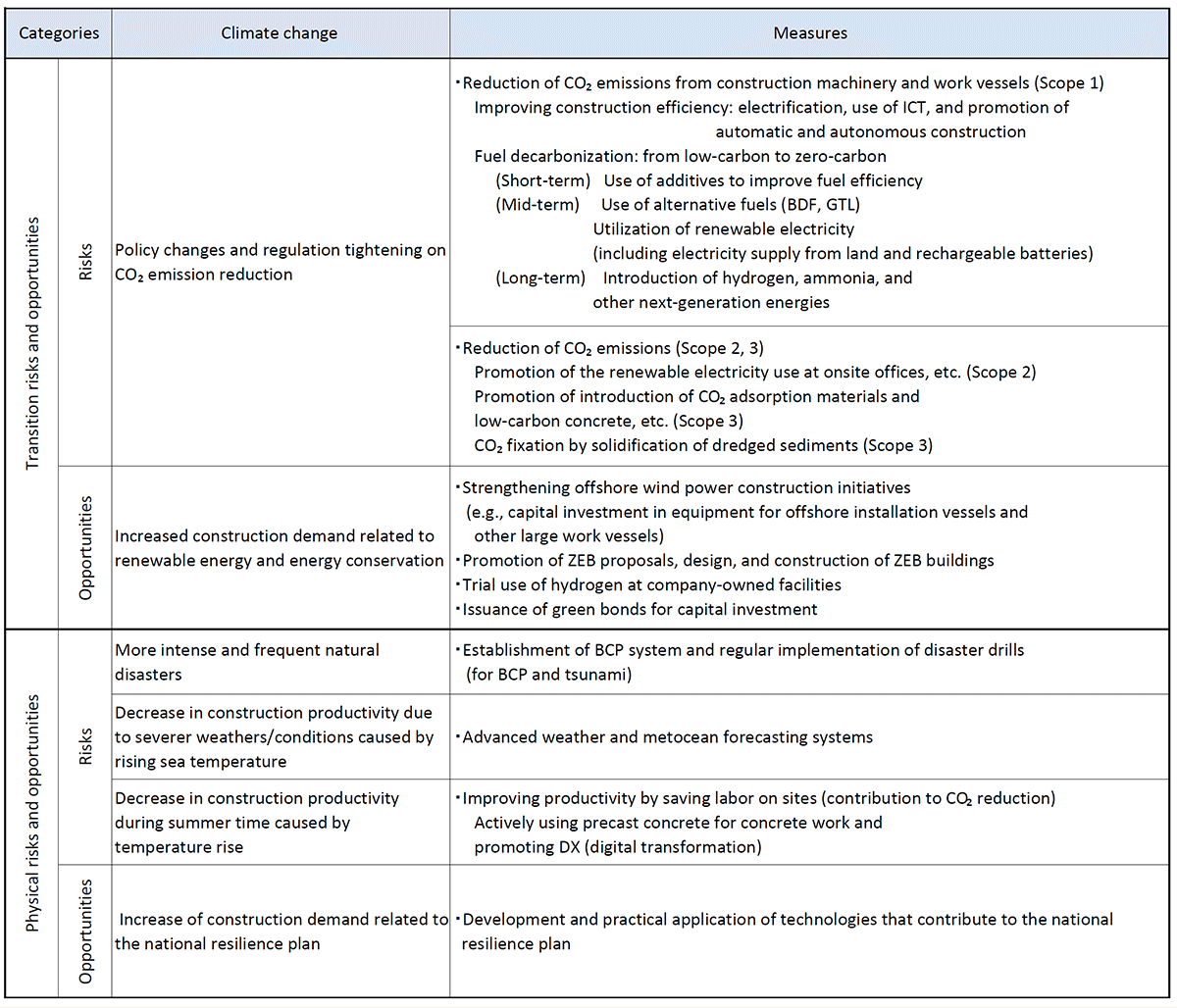This Page is Home![]() Updates
Updates
What's New
Penta-Ocean Construction Co., Ltd.
Takuzo Shimizu, President, CEO and Representative Director
Support for TCFD recommendations and related information disclosures
Tokyo, Japan – May 13, 2022 –Penta-Ocean Construction Co., Ltd. hereby announces that we have expressed our support for the recommendations of the Task Force on Climate-related Financial Disclosures ("TCFD*1") established by the Financial Stability Board ("FSB"), and joined the TCFD Consortium*2.
Under our CSR basic policy of “the greatest contribution to society is the construction of superior infrastructure”, we conduct CSR oriented management with focus on ESG. In the construction industry, CO2 emissions from construction activities are relatively small compared to other industries. However, marine civil engineering work, which is one of our fortes, is characterized by higher CO2 emissions than other construction projects because of the use of work vessels. In addition, looking at the supply chain as a whole, construction projects are characterized by the use of steel, cement and other materials that emit a large amount of CO2 during the manufacturing stage, as well as the long service life of buildings and infrastructure structures after completion, resulting in a large amount of CO2 emissions during the operational stage.
We believe that responding to climate change issues is one of our most important management issues, and we will undertake initiatives to reduce CO2 emissions from our construction activities. By promoting the construction of offshore wind power facilities and zero energy buildings (ZEB), we will strive to achieve carbon neutrality by 2050 through our core business.
Furthermore, we will promote proactive information disclosure based on TCFD recommendations, as outlined on the following pages. Going forward, in light of the global socio-economic situation and technological development, we will continue to assess the risks and opportunities that climate change may pose to our businesses, and verify the effectiveness of CO2 reduction measures in our business activities and review them as appropriate.

| *1 | Task Force on Climate-related Financial Disclosures (TCFD) is a framework established by the Financial Stability Board at the request of the G20 countries to encourage companies and others to disclose information on governance, strategy, risk management, metrics and targets related to climate change-related risks and opportunities. | |||
| Governance | : | The organization’s governance around climate-related risks and opportunities | ||
| Strategy | : | The actual and potential impacts of climate-related risks and opportunities on the organization’s businesses, strategy and financial planning where such information is material | ||
| Risk management | : | How the organization identifies, assesses and manages climate-related risks. | ||
| Metrics and targets | : | The metrics and targets used to assess and manage relevant climate-related risks and opportunities where such information is material |
||
| *2 | A consortium established by companies and financial institutions that support the TCFD's recommendations in order to discusses effective information disclosure and initiatives to use the disclosed information for appropriate investment decisions by financial institutions, etc. | |||
Information disclosure based on TCFD recommendations (outline)
1. Governance
We believe that responding to climate change issues is one of our most important management issues. To this end, we established in July 2021; 1. The Carbon Neutral (CN) Promotion Committee chaired by the President and Representative Director, and 2. The CN Promotion office for its designated department, to further enhance initiatives for reducing GHG emission beyond the boundary of Business Units.
The CN Promotion Committee was newly established and operates under the CSR Committee (chaired by the President and Representative Director), which supervises the company’s overall CSR management (the sustainability management) with focus on ESG, along with the Risk Management Committee, the Environment Health and Safety Committee, the Quality and Environment Management Committee and the Work Style Reform Promotion Committee. The CN Promotion Committee plans and formulates basic policies and strategies for the Group’s initiatives to tackle the global climate change issues, and deliberates climate related matters based on the monitoring results of the progress of each measure. The Committee decisions are reported to and discussed at the CSR Committee. The Committee decisions on policies and strategies are incorporated into business plans of each Business Unit and the company-wide annual plans and mid-term plans, and they then progress towards implementation. The Board of Directors receives reports from the CSR Committee and supervises all sustainability related issues including climate-change issues.
The implementation progress of measures to address climate change issues will be continuously monitored by the CN Promotion Committee, in order to review and improve our policies and strategies.

2. Strategies
In the construction industry, CO2 emissions from construction activities are relatively small compared to other industries. However, looking at the supply chain as a whole, construction work is characterized by the use of steel members, cement, and other materials that emit a large amount of CO2 during the manufacturing stage, as well as the long service life of buildings and infrastructure structures after completion, resulting in a large amount of CO2 emissions during the operational stage. In addition, the marine civil engineering work, which is one of our fortes, is characterized by higher CO2 emissions than other construction work and civil engineering work performed on land, because of the use of work vessels.
Due to the operation of our work vessels, our strength in marine civil engineering work brings about higher CO2 emissions compared to other industry peers with the same scale of completed construction volume. Because several large dredgers are in operation overseas in particular, if we take the fiscal year ending march 2020 (FY 3/20) as an example, which is the base year for CO2 emission reduction, our overseas CO2 emissions are approximately 1.9 times higher than that in Japan, despite the fact that the overseas completed construction volume was only approximately 40% of the domestic volume. Therefore, the impact of climate-related policy changes and tighter regulations on our corporate management is relatively large compared to our industry peers. For that reason as well, we believe that our response for climate change issues to be one of our most important management issues.
As part of our initiatives to tackle these issues, we have identified the risks and opportunities that climate change may pose to our group, and analyzed the likelihood of their occurrence and the extent of their impact. We conducted multiple scenario analyses of those of high importance.
Risks were categorized as 1. "Transition risks" resulting from policy changes and tighter regulations to reduce CO2 (including amendment on The Act on the Rational Use of Energy, mandatory use of ZEB technologies and introduction of carbon taxes), associated with the transition to a low-carbon society, and 2. "Physical risks" resulting from chronic temperature increases and more intense and frequent extreme weather events.
We analyzed opportunities related to climate-change issues and identified potential business opportunities in response to the above-mentioned transition risks and physical risks. For scenario analyses, we constructed two different scenarios* : the "1.5 - 2°C scenario", in which the temperature increase at the end of the current century is limited to no more than 1.5 - 2°C compared to pre-industrial times, and the "4°C scenario", in which the temperature increase exceeds 4°C. Under these two scenarios, we identified the risks and opportunities and then conducted quantitative analysis of their impact on the Group's finances in the year 2030. The results of the analysis were defined on a three-point scale of "major," "medium," and "minor”.
As a result of the analyses, we expect to see an increase in capital investment in maintenance, renewal, and new construction of work vessels to achieve their carbon neutrality. We believe, however, that we will witness more business opportunities for our company that outweigh these drawbacks. The opportunities include the promotion of offshore wind power generation construction in the civil engineering field, and the promotion of ZEB application in the building construction field. As a company with distinctive strengths in marine civil engineering technology and as a front runner in offshore wind power construction, we will contribute to the expansion of renewable energy supply in Japan.
We will incorporate the risks and opportunities identified through the above scenario analyses into our annual business plan as well as the next mid-term management plan (FY 3/24 – FY 3/26), and ensure their implementation, in order to contribute to the development of a sustainable society.
| *1.5-2℃ Scenarios: | IEA/Sustainable Development Scenario (SDS), IEA/Net-Zero Scenario (NZE), IPCC/Representative Concentration Pathways Scenario (RCP 2.6) |
| 4℃ Scenarios : | IEA/Stated Policies Scenario (STEPS), IPCC/Representative Pathways Scenario (RCP 8.5) |
■The risks and opportunities of our group

■Countermeasures

3. Risk management
The Risk Management Committee, established under the CSR Committee and chaired by the President and Representative Director, is the core of our risk management system. They systematically categorize risks assumed in our business activities, assign a department in charge for each risk, and conduct overall risk management. With the aim of preventing the occurrence of risks and minimizing losses associated with various risks including climate change, which may arise in the course of our business activities, we have established the "Risk Management Regulations"
The CN Promotion Office is the department in charge of climate change risks. They identify, evaluate and implement countermeasures against each risk from a long-term perspective. Whenever revisions to laws and regulations or changes in socioeconomic conditions necessitate changes to risk countermeasures, the CN Promotion Committee will review individual risks and countermeasures as appropriate. The results of deliberations of the CN Promotion Committee will be reported to and discussed by the CSR Committee, and the activities of the CSR Committee will be reported to the Board of Directors, which will oversee the implementation of climate change risk management. In the event of the occurrence of climate change risk, it is promptly reported to the supervising department, determined according to the degree of impact on corporate management (major risks are reported to the Board of Directors). As described above, we have a system in place to respond to risks in a timely and appropriate manner.
4. Metrics and targets
We have been working to reduce CO2 emissions from our domestic business activities by 20% from the FY 3/1991 level (56.95 t-CO2/100 million yen) by FY3/21, and by 30% by FY3/31. In FY3/21, we achieved a 25% reduction in CO2 emissions (42.56 t-CO2/100 million yen), far exceeding our target.
With the aim of achieving carbon neutrality by 2050, we have set a CO2 emission reduction target with the base year of FY 3/20, including our overseas operations, which account for the majority of our CO2 emissions.
To reduce Scope 1 and 2 emissions, we will actively use renewable energy sources such as solar and wind power, electrically power our work vessels and construction machinery, improve construction efficiency by utilizing ICT and promote the introduction of automatic and autonomous construction. On the fuel front, we will use additives that improve fuel efficiency for work vessels and construction machinery in the short term, and in the medium term, we will promote use of alternative fuels (BDF, GTL) and renewable energy-derived electricity (including land-based electricity supply and large-capacity rechargeable batteries) as fuels for work vessels and construction machinery. In the long term, we will introduce hydrogen, ammonia, and other next-generation energy sources to reduce CO2 emissions. We will start by visualizing CO2 emissions at construction sites. At our green-model construction sites, we will ensure energy conservation through more efficient construction and use additives that improve fuel efficiency for heavy oil and diesel oil and use ZEB construction offices (which utilizes renewable energy-derived electricity). These initiatives will be rolled out to all construction sites by FY 3/31.
For Scope 3 emissions, we will promote the conversion of our buildings to ZEB, i.e., energy conservation and the use of electricity derived from renewable energy sources such as solar power generation, and reduce CO2 emissions by expanding the use of CO2 adsorbent materials and low-carbon concrete. In the building construction sector, we will promote ZEB conversion, especially in our design-build projects, and in the civil engineering sector, we will actively use precast concrete (PCa) and low-carbon concrete. We will also promote research on CO2 fixation by solidification of dredged sediments and low-carbon concrete.
Our CO2 emission reduction targets are consistent with scientific findings, and we are currently applying for SBT (Science Based Targets)*1 certification.
■Our Group's targets for CO2 reduction (in thousand ton -CO2)

| *1 SBT: | An international initiative that encourages companies to set GHG reduction targets that are scientifically consistent with the Paris Agreement. Our reduction targets are consistent with the reduction level required to limit the rise in global temperature to 1.5°C above pre-industrial levels. |
| *2 Scope1: | Direct emissions from fuel use by work vessels and heavy machinery |
| *3 Scope2: | Indirect emissions from the use of purchased electricity and heat |
| *4 Scope3: | Indirect emissions in the supply chain. Note that in FY 3/20, the base year, category 11 (CO2 emissions from the use of buildings after completion and delivery) accounted for 71% of Scope 3 emissions, Category 1 for 26%, and together they accounted for 97% of Scope 3 emissions |
